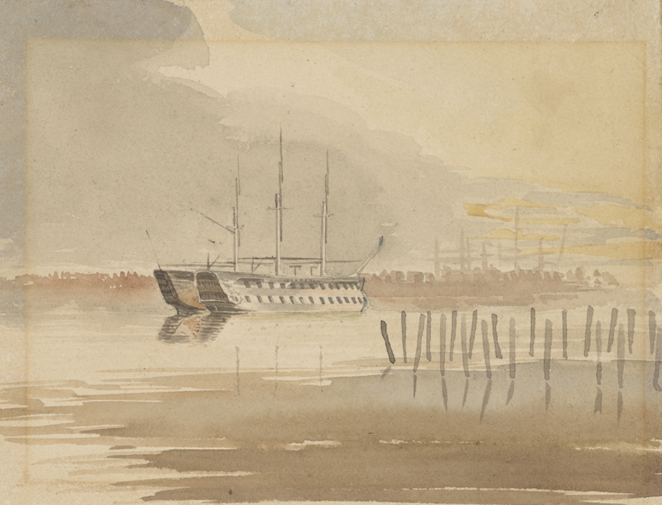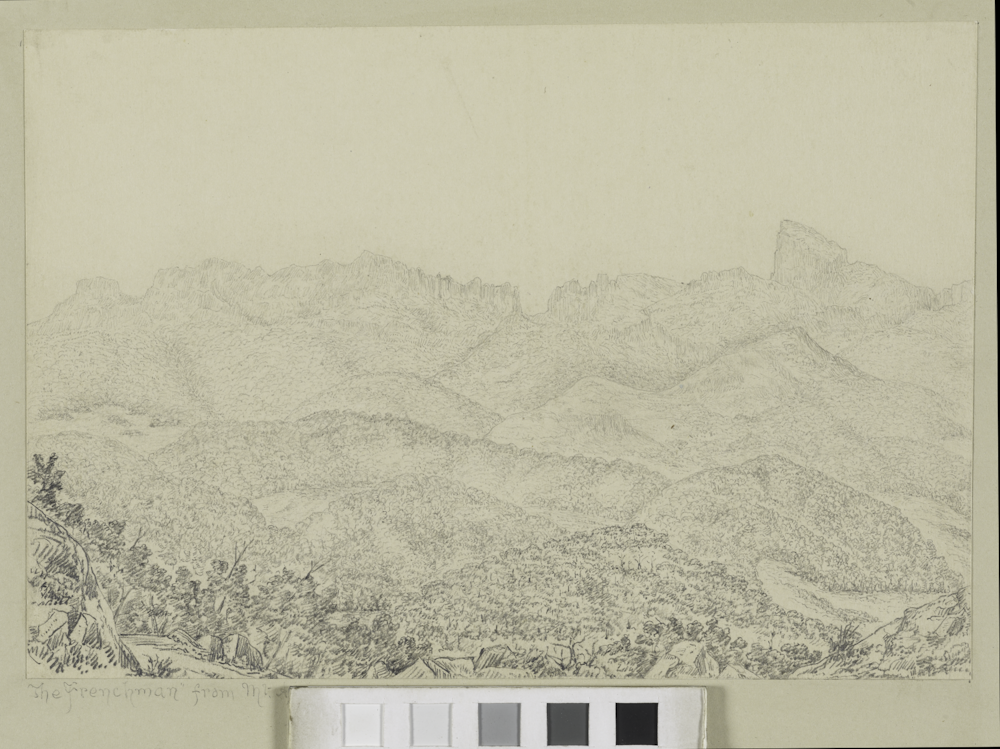Stories from the Royal Society of Tasmania Art Collection
14. GTWB Boyes – an Artist and a Diarist.
Article prepared by the RST Honorary Curator, Dr Anita Hansen, for the August 2023 RST Newsletter.
George Thomas William Blamey Boyes – a member of the John Skinner Prout cohort who painted ‘plein air’ watercolours is this month’s protagonist, and he is arguably as well-known as a diarist as an artist.
As well as having a number of his watercolours in its art collection, the society also has in its library his diaries and letters (RS25–26, RS7/107 and RS3/1(1)). The letters were donated by Miss Boyes in 1960, while the diaries were donated by CE Boyes from 1941–6.
In 1946, WH Hudspeth wrote about Boyes (and Rev Robert Knopwood) in the Papers and Proceedings of the Royal Society of Tasmania, and later in 1954 he published Early Van Diemen’s Land.
The artworks are cited as being donated by CH Bowling in 1952, and the paintings are noted in the 1969 Loans List, as well as the RST Accessions List.
The thing I’ve found particularly interesting about my research for this article, are the contradictions in the material I have discovered. Boyes appears to have been a person who divided opinions. One piece will note him to be, ‘a capable, prudent, agreeable, and eminently respectable official’, while another will say of him that he was, ‘an embittered man … [who] hadn’t a good word to say for anyone’.
The Australian Dictionary of Biography (ADB) notes, ‘Outwardly cordial and modest, Boyes privately scorned his superiors as a ‘dirty pack of unprincipled place hunters’, and the colonists as ‘radicals of the worst kind … ever ready to impute the basest motives to their fellow[s] … Lying, slandering, every hatred and malice are their daily aliment and the consumption is incredible’. He considered himself refined, and bitterly regretted that circumstances forced him to live in a society given over to gross commercialism and sordid political intrigue. From this discontent sprang his writing.’
Among the duties entailed by Mr. Boyes’ official position was that of attending parties at Government House, and his description of some of these is worth quoting: At another [party], given by the Franklins: ‘An evening party, about 450 present; came away about 2 o’clock heartily tired with the bad supper, bad dancing, stupid people, and the clouds of dust.’ (WH Hudspeth)
So, it looks like the opinion one had of Boyes could depend on your social standing, or whether one has read his diary or not.
‘Some sort of Government official’

This image from the National Library of Australia’s records is amusing – ‘Boyes was some sort of Government official, (I forget now exactly what)’. Boyes was posted to Van Diemen’s Land as its Colonial Auditor in October 1826. During his time in VDL, Boyes held the positions of; Colonial Auditor, Colonial Secretary, Caveat Commissioner, Member of the Executive and Legislative Councils, and Member of the Committee of the Queen’s Orphanage.
GTWB Boyes (1786/7–1853)
Boyes was born in Hampshire, England, the son of a Hampshire gentleman and property-owner, Thomas Boyes. His mother, Ann (nee Blamey), died shortly after his birth.
Again, the information available on Boyes’ early life is contradictory. The Dictionary of Australian Artists Online (DAAO) states that after his mother’s death, ‘Boyes moved from household to household and from school to school’, while the Australian Dictionary of Biography (ADB) states that, ‘he was educated by various private tutors. By his 13th year he had attended six educational establishments in or near Portsmouth’.
He seems to have been interested in painting and drawing from an early age, and it was considered a suitable activity for young gentlemen at that time, so this is perhaps not surprising.
Early artistic influences came from the Hampshire school of landscape and marine painters, including John Livesay, professor of drawing at the Portsmouth Naval College, with whose son he walked and sketched in Wales, and possibly from the painter, engraver and former pupil of Benjamin West, Richard Livesay (1750–1823), who also taught at the college. Boyes was a friend of another teacher there, John Christian Schetky, later marine painter to the King and collaborator with J.M.W. Turner on some of his marine paintings. One of Boyes’ letters suggests he himself may have taken tuition from Turner in 1819.
[Dictionary of Australian Artists Online]
In 1809, Boyes joined the Commissariat Department of the army, and spent some years in the Peninsular war, serving under the Duke of Wellington. His former drawing teacher JC Schetky was also at the Peninsula at the time. Schetky’s influence on Boyes’ style can bee seen when comparing similar subject matter.


Bernard Smith, arguably the most influential writer on nineteenth century art in Australia, wrote of Boyes in European Vision and the South Pacific, ‘An outstanding and yet, in many ways, a representative member of this group [the group surrounding John Skinner Prout] was George Boyes … an enthusiast for the romantic and the picturesque … Boyes cultivated the arts not as a means towards a better understanding of an unfamiliar part of the world but as a manifestation of taste, culture, and sensibility.’
Smith also quotes Boyes’ diary entry of 9 September 1831 after a visit to John Glover, ‘Walked with Hill up to the Glovers. Saw his picture of Mount Wellington. Sun rising and Moon setting in its finished state. I like the twilight part of it very well … a very gaudy effect of Sunshine – where the Trees in the foreground are designed with hideous fidelity to Nature.’ (p217).
Boyes seemed to criticise all the local artists, in his diary entry on 15 August 1857 he writes a scathing criticism of a painting John Skinner Prout had given him, ‘a poor washy thing not worth a frame’.
Although he criticised the art of others in Van Diemen’s Land at the time, it did not stop him from also being part of the Hobart Art Exhibition in January 1845. He wrote in his diary:
Sent 6 pictures to the exhibition before breakfast. Called at the Exhibition on the way to the office. With Bicheno in the afternoon [Bicheno took over Boyes’ position as Colonial Secretary]. Walked down with him to look at the pictures. The Bishop [Nixon] passes a good deal of his time there. Bustles about. Runs up and down the library steps, suggests, alters, chatters to everybody and takes such an interest in the affair that one might suppose his own reputation as a connoisseur of fine arts depended upon the success of the exhibition. [28 Dec 1844]
Boyes and Bicheno formed a sketching group of their own which included the Colonial Treasurer and amateur painter Peter Fraser and Bishop Francis Russell Nixon, a remarkable combination of ‘Art and Government’ in Van Diemen’s Land. In their informal sketching club included such major colonial artists as Simpkinson de Wesselow and John Skinner Prout, and Boyes’ diary has much useful detail of their activities. While Boyes and Bicheno also indulged their joint musical enthusiasms by promoting soirées and instrument quartettes, undoubtedly their most important cultural alliance was in the promotion of the Hobart Town Art Exhibition of January 1845 – regarded as the first Fine Art exhibition in Australia – at which Boyes exhibited Cottage Scene, after S. Prout – sadly not part of the society’s art collection.
A trip back to England
In 1832 Boyes returned to England after nine years away to bring his wife Mary (nee Ediss) and their family back to Tasmania with him. While there he immersed himself with art matters, visiting his old teacher John Shayer and making numerous technical notes on his work. He sailed back to Tasmania on the convict transport Moffat with his wife and four sons arriving in 1834, and resumed his colonial auditorship. He was appointed legislative councillor in 1840. (ADB)
kunanyi/Mount Wellington
Boyes, like many other artists of the time, was fascinated by kunyanyi/Mt Wellington. He painted and wrote about it often.



Three Boyes’ paintings of kunanyi/Mount Wellington from the Royal Society of Tasmania Art Collection. It is interesting to see Boyes’ styles here; from a very rough, quick watercolour sketch most likely painted on site, to a more worked up painting, to the final very finished piece.
On February 13 1831, Boyes wrote in his diary:
At home all morning. In the afternoon rode Bryant’s horse beyond Roseway across the stream and into the woods on the other side. Magnificent scenery – Mt Wellington rearing his giant head above the tall trees at every turn – and the deep purple shadows of the Ravines formed fine contrasts with the bright parts rich with streams of yellow light from the declining light. [Visions of Australia, Eric Rolls, p82]
Although much maligned and perhaps not given as recognition as he should be for his role in documenting the early history of European settlement in Van Diemen’s Land, GTWB Boyes leaves us, like his contemporary Louisa Anne Meredith, important written and visual records of early Tasmania.
Boyes died at Hobart on 16 August 1853.
Do you know this artist?
In the Royal Society of Tasmania Art Collection are four unidentified sketches of Tasmanian scenes. The artist has a very distinctive way of mark making, particularly the hatching of the rocks. Each of these images can be enlarged by clicking on them.




If anyone can identify the artist I would be very interested in hearing from you.

